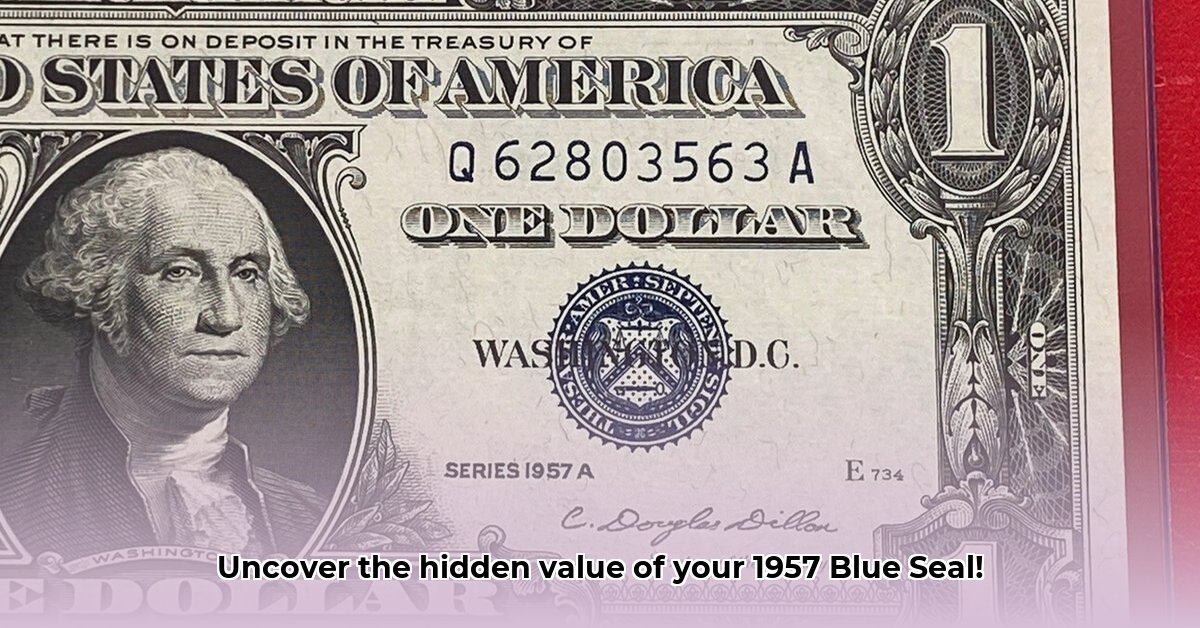
The 1957 one-dollar blue seal, officially a Silver Certificate, is a fascinating piece of American history. While millions were printed, their value varies greatly. This guide helps you determine your bill's worth, whether you're a seasoned collector or just starting out. We'll cover key identifying features, factors affecting value, and even how to spot those rare, high-value gems. For more information on other valuable bills, check out this resource on other valuable bills.
Identifying Key Features and Assessing Value
The condition of your bill is paramount to its value. Think of it like a classic car: a pristine model is worth far more than a rusty wreck. But beyond condition, several other factors significantly impact a 1957 Blue Seal's worth.
Condition: The Foundation of Value
Accurate grading is critical. While professional grading services offer detailed evaluations, you can make a preliminary assessment yourself. Use a magnifying glass and good lighting to examine for wrinkles, rips, tears, stains, or fading.
Here's a simplified grading scale:
- Poor: Heavily damaged; barely recognizable.
- Fair: Significant wear and tear, but mostly intact.
- Good: Considerable wear, but main features visible.
- Very Good: Light wear, most details sharp.
- Fine: Minimal wear, most details visible.
- Very Fine: Excellent condition; little wear.
- Extremely Fine: Practically perfect, almost flawless.
- Gem Uncirculated (AU): Looks brand new; never circulated.
Beyond Condition: Factors Affecting Value
Several factors beyond condition influence value. Let's explore them:
Serial Numbers: Repeating numbers (e.g., all 7s), extremely low or high numbers, are highly prized. "Star notes" (with a star printed after the serial number, indicating a printing error) are especially valuable.
Series: 1957, 1957A, and 1957B series exist, each distinguished by the Treasury Secretary and Treasurer's signatures. While not dramatically altering value, these subtle differences matter to collectors.
Historical Significance: The 1957 Blue Seal was the first $1 bill to feature "In God We Trust" and the last printed while the U.S. was on the silver standard. This historical context adds to its appeal but won't drastically increase value unless paired with excellent condition or a rare serial number.
Determining the Value of Your 1957 One Dollar Blue Seal
The following is a rough value guide. Actual value depends on current market conditions and collector demand. Always consult reputable numismatic resources for the most up-to-date pricing.
| Condition | Approximate Value Range (USD) |
|---|---|
| Circulated (Poor-Good) | $1 - $5 |
| Very Good - Fine | $5 - $15 |
| Very Fine - Extremely Fine | $15 - $50 |
| Gem Uncirculated (AU) | $50+ (depending on serial number) |
| Star Notes | Premium added to above ranges |
| Rare Serial Numbers | Significantly higher premiums (>$750+) |
Tips for Collecting 1957 Blue Seal Notes
Here's advice for both novice and experienced collectors:
Handle with Care: Protect your bills using acid-free sleeves and storage. Damage significantly reduces value.
Research Serial Numbers: Learn about valuable serial number patterns and variations. Online resources and numismatic publications are invaluable.
Professional Grading: For high-value bills, professional grading provides an objective assessment and increased confidence in its worth.
Enjoy the Hunt: Finding a valuable bill takes patience and persistence – but the thrill of the chase is part of the fun!
How to Identify Valuable Serial Number Variations
Understanding serial number variations is crucial for maximizing your collecting potential. "Fancy" serial numbers—those with repeating digits, mirrored sequences, or other patterns—command premiums due to their rarity.
"Star notes," identifiable by the asterisk after the serial number, are also more valuable than standard notes because of their limited supply. Further, the specific series (1957, 1957A, 1957B) can also have an impact on the value.
Remember, always authenticate your bills through professional means to ensure you're dealing with genuine notes. Sites like SerialWorth (https://www.serialworth.com/) offer additional pricing information, but should not replace expert appraisal for particularly valuable finds. However, even a common 1957 Blue Seal holds a piece of American history, making it a valuable addition to any collection regardless of its monetary worth.